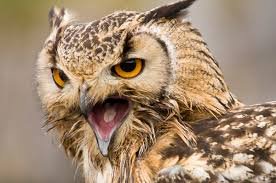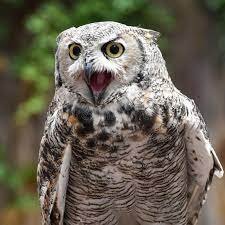Introduction
Owls are bizarre nocturnal creatures. They are secretive birds also considered opportunistic birds and they have a secretive attack on their prey and also their predator to protect themselves. There are different species of birds that produce different sounds in different situations. Owls produce different sounds depending on their situation, they will bark when they are surprised or frightened, they will screech generally after dusk and before dawn, they will produce growling sounds to dissuade threatening animals or predators and they will hoot generally at night in the dark. So, the owl’s hooting sound is most probably the common sound that can be heard from a far distance. It is easily identified. But, the question is why do owls produce a hooting sound?
Hooting sound

This sound is a most common and recognizable one which is known as “The sound of Owls“. Great horned owls are the ones who mostly produce hooting sounds and are essentially called the hooting owls of the United States. These sounds include two times ‘hoo, hoo’ and with a deep noise followed by a long stretched sound of ‘hoooooo’. These sounds can be heard from a long distance. Male owls produce deeper hooting sounds than the females. It is very common to hear this sound at dusk and till midnight, especially in the woodlands of parts of America.
Why do owls hoot at night?
The person can easily identify the hooting sound as an owl and it is generally heard at night. The owls produce a hooting sound at night because they are:
- Protecting their territory from other Owls.
- Screeching or low-pitched barking voice is produced by them because they feel threatened or need to protect their territory
- Hooting sound also signifies attracting a male mate and starting setting up their province. They choose nighttime as their designated hoot time because most owls, not all, are nocturnal animals.
Owls defend their territories and their babies from the other predators and declare new territories through these hooting sounds. They also use different sounds and calls which shows they are doing this to mate and meet possible counterparts.
Owls do produce a wide variety of sounds and unique calls at night, for a variety of reasons. Whether they are fighting over territory or simply doing this out of their excitement or fun, whatever is the reason here are all of the different reasons owls hoot at night.
You might also be interested to know How do baby owls sleep?
- Territorial Disputes

Owls often call out in the night over territorial disputes. While owls are capable nesters, they often claim the nests made by other birds. This is why they call so often at night about it: they are staking a claim over a specific nest or location, and they don’t want any other bird to bother them.
These calls often echo for miles, depending on the owl breed who is doing the vocalizations. The point is that the owl wants all surrounding owls to hear that they have staked a claim. They don’t want any other raptor stealing their nest or tree as they begin to build their home!
This call is typically used by male owls, regardless of breed. Territorial disputes often happen between males, and these calls also work as a type of mating call. Female owls hear males during territorial disputes and can choose to pursue them if need be.
- Courtship
Speaking of, owls often hoot at night for courtship reasons. A male owl calls out into the night, waiting for a call in return. This is what makes courtship hooting special: there is a call and response to the process, making it entertaining to overhear. Female owls hoot back at males if they are interested in mating, and you can often hear the differences between a male and female owl call.
- Surprised noises

It isn’t easy to surprise an owl, but they will have something to say about it. Like many other birds, owls are capable mimics, known to both bark and growl when threatened or surprised. Owls will also puff up to appear larger should they be surprised, so it is always best to use caution when approaching any owl that isn’t expecting you!
- Mating Hoots
Both male and female owls also have their mating hoots. Usually, the male will start with a deep hoot to see if there are any females nearby. The female will then respond with a slightly higher-pitched hoot to let the male know that she’s interested.
This back and forth hooting can last for some time before the two owls get together. More often than not, the male owl will come to the female and she must then decide whether he’s the perfect mate for her. After all, most owls do mate for life, so it’s an important decision. Some species of owls, like the Eastern Screech-owl, will make a screeching or screaming noises when they want to attract a mate. This can almost sound like a woman screaming and could be quite unnerving if you’re out camping in the wild.
When is it most likely to hear owls hooting?

The first sound an owl will make occurs while it is still inside the egg before hatching; chicks will make chirps while growing in the nest. The first hoots by juvenile males are practiced during their first winter, but it takes time for these young birds to vocalize sounds correctly like their parents.
Fully mature adult owls shoot in earnest during the breeding season, usually from late winter to early spring (but this timing varies by species and geographic location). Hoots are used frequently at this time of year to communicate to potential mates, current mates, and other neighboring owls.
FAQs
Where do owls go during the day?
While owls are hunting during the day, most of them sleep and take a rest after a night of hunting. They return to their resting place called a roost. Some owls may be roosting by themselves and some may roost communally.





